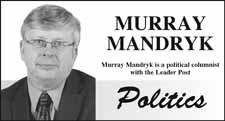They have always said that everyone in Saskatchewan has at least one foot on the farm. To some extent, this remains true.
But there are a few other realities we factor into this old cliché.
First, both Regina and Saskatchewan have been near or over 200,000 people for a generation now, so that connection to the farm increasingly means through a grandparent or uncle or aunt. Second, the growth in this province right now is through immigrants or Canadians from other provinces as much as it is people moving in from the country.
Third - and most importantly - you can't simultaneously be from both rural and urban Saskatchewan, anyway. You can be from a farm or a small town and that special bond may never leave your heart. But to suggest that the immediate needs and interests of city residents from Regina and Saskatoon are the exact same as those currently living in rural Saskatchewan has always been a ludicrous notion.
For these reasons, it appears that the federal electoral boundaries commission of Justice Ronald Mills, Professor John Courtney and SARM President David Merit has got Saskatchewan's new boundaries right. Let us just hope that the politicians don't screw it up again like they did last time.
The new boundaries in Saskatchewan would see Regina and Saskatoon residents represented by three seats (instead of the current four) called Saskatoon Centre-University, Saskatoon West, Regina Lewvan, Wascana and Regina Qu'Appelle and Saskatoon Grasswood. Only the latter two would have a combination of rural and urban voters.
Meanwhile, there would still be seats called Cypress Hills-Grassland, Souris-Moose Mountain, Prince Albert, Yorkton-Melville and Desnethe-Missinippi-Churchill River in the north. However, they would be joined by "rural" seats called Kindersley-Rosetown-Humboldt, Lloydminster-Battlefords-Rosthern and Moose-Lake Centre-Lanigan. The total would remain 14.
Notwithstanding the usual concerns about the physical size of depopulated rural ridings or the quibbling of which communities belong in the same riding, these boundaries clearly makes more sense than the existing ones that see eight of the province's 14 seats split between rural and urban.
Even the provincial boundaries commission - flawed as it might have been in adding three additional seats in this province when it was unnecessary to do so - recognized the inherent unfairness of urban-rural split seats. (Only two of new 61 provincial seats see any form of rural-urban split.)
The logic would seem evident to us all. No matter how tied rural and urban Saskatchewan residents truly are, their immediate needs and issues are, and have always, been different. For that reason, it is infinitely logical to represent public interest in the way that current boundaries commission has.
The problem, however, is political interests aren't always the same as public interests ... which is how the current boundaries got so badly screwed up last time.
Prior to establishment of the current boundaries, the interim boundaries proposed a much better interim map that represented the traditional urban and rural seats for this province. Unfortunately, self-interested politicians successfully fought to changed the boundaries.
Most vocal were the NDP - specifically then NDP Regina-Palliser MP Dick Proctor - who argued his new rural riding stretching from the U.S. border to the outskirts of Saskatoon called "Long Lakes" was just too big with too many communities with no common interest. As a result, we got ridings like Regina-Qu'Appelle that take in everything from inner city Regina to the rural communities 100 miles north. (Ironically, the NDP did not elect a single MP under the current boundaries.)
Already, politicians like Conservative Saskatoon-Rosetown-Biggar MP Kelly Block are complaining about the unfairness of the new ridings that "break" the tradition of split urban-rural seats in Saskatchewan.
Sadly, Block is as wrong as she seems self-interested. The proposed riding boundaries make far more sense.
Let's hope they don't change.
Murray Mandryk has been covering provincial politics for over 15 years.




